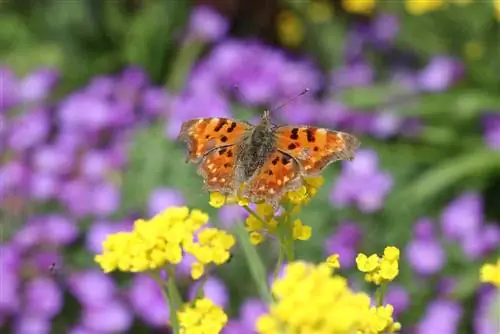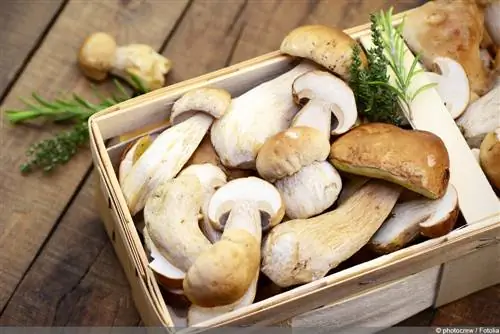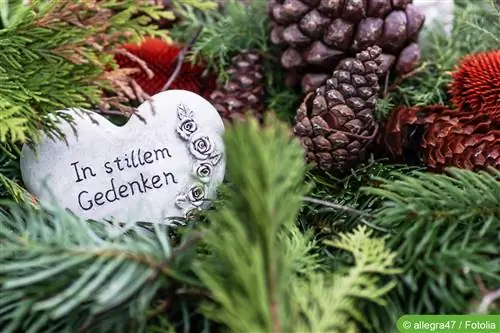- Author admin [email protected].
- Public 2023-12-17 03:39.
- Last modified 2025-01-24 12:45.
In summer, butterflies adorn nature with their magnificent colors, but in late summer the butterflies (Lepidoptera) become less and less visible until they usually disappear completely in autumn. You start preparing for the cold season quite early. Some, like some bird species, migrate to southern climes where it is warmer, while others prepare for winter differently depending on the butterfly stage or life cycle. Experts explain how and where they spend the winter.
Wintering
When it comes to butterflies and how they overwinter, it depends on which life cycle they are in. In addition, some butterfly species do not overwinter in the cold areas of Western Europe. In total there are five wintering strategies, which fundamentally relate to the following:
- F alter
- Dolls
- Caterpillars
- Eggs
- Withdrawal to the south
F alter
Of the over 180 species of butterflies currently known in Western Europe, only six Lepidoptera species overwinter in the cold region. These psyllids, as they are also called, are the only ones that spend the winter in their moth form.
When autumn begins, they look for a sheltered place where they can find protection from both predators and the cold. So they mainly choose caves, like those found in some trees. But they also often find their winter quarters in garden sheds or cracks under roof tiles. Especially in urban areas, where there is little nature to invite you to overwinter, they may also look for a place to overwinter in warmer basements.
TheLepidoptera species that overwinter in local areas include:
- Little Fox
- C-F alter
- Lemon butterfly
- Peacock butterfly
- Admiral Butterfly
- mourning cloak
Winter torpor
Butterflies are among the cold-blooded groups of animals. This means that their body temperature can adapt to outside temperatures. If these drop, the body temperature also drops, up to 0 degrees Celsius. Then they fall into what is known as hibernation. Winter torpor usually occurs at ambient temperatures of around five degrees Celsius. In advance, at temperatures between ten and 15 degrees Celsius, the butterflies begin to reduce their metabolism. Breathing becomes increasingly shallow, the tubular heart slows the heartbeat and movement activity decreases rapidly. This process is completed during the transition to winter torpor and organ functionality is then only between three and seven percent compared to spring and summer.
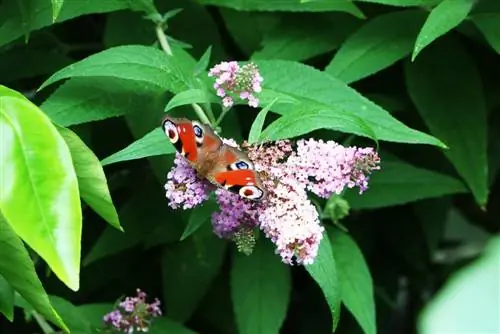
By shutting down all vital functions and maintaining a motionless posture, the butterfly does not need any food because the energy requirement during hibernation is also reduced to a minimum. They do not have energy reserves, as is the case with the frog, for example, which eats up a fat deposit in advance, which also serves to warm the body.
Unfreezing
If the ambient temperatures rise to over eight degrees Celsius, the butterfly “wakes up” from its winter torpor. As a rule, however, he only returns to “normality” when the nectar is waiting for him outside again. This is usually the case from March onwards, although some specimens leave their winter quarters in January or February.
Dolls
The butterfly pupae predominantly overwinter on plant stems or other parts of plants. There they are wrapped in a cocoon so that they do not fall down. But they also find suitable winter quarters when buried in the ground. Unfortunately, overwintering for pupae is no longer so easy these days. This is due to the fact that fields are often dug up in autumn, many plants are sometimes heavily pruned in the winter and the soil is lifted in the gardens by leaf hooks.
If the pupae have already settled down here for the winter, they are maneuvered out of their safe quarters and handed over to their predators, such as birds or mice.
Butterflies will therefore be seen less frequently in the following year. If the pupae survive the winter in a suitable place, they develop further in the spring and then flutter through the air as butterflies from around April or May.
The butterflies that overwinter as pupae include:
- Whites
- Swallowtail
- Aurora butterfly
Caterpillars
Caterpillars can overwinter in cold climates both as young caterpillars and as semi-adult and adult caterpillars. Depending on the butterfly species, they spend the cold winter time in different places. Some prefer a spot among vegetation, while others attach themselves to plant stems or the undersides of leaves. Certain butterfly caterpillars also build dense webs especially for the winter, which offer them protection in rock crevices or similar. The caterpillars of the “ant blue” butterflies are drawn to ant nests to spend the coldest season there.
The following butterfly caterpillars overwinter in one way or another:
- Bluelings
- Great Iridescent Butterflies
- Chessboard
Winter torpor
Like the butterflies, the butterfly caterpillars fall into winter torpor. Your body system slows down by over 95 percent, the body becomes immobile and the body temperature drops to 0 degrees Celsius. In contrast to the butterflies, they eat up plenty of fat deposits until the beginning of autumn so that the caterpillar's body can feed on them during the torpor of winter. This means he can get through the time well without having to eat, as the winter torpor also reduces his energy requirements by around 95 percent.
End of winter
If the temperatures rise in February/March, the torpor slowly disappears, the temperature rises evenly with the outside temperature and the butterfly caterpillars become active again. In spring they eat their fill again in order to absorb enough energy so that they can then move on to the next developmental stage of pupation.
Butterfly eggs
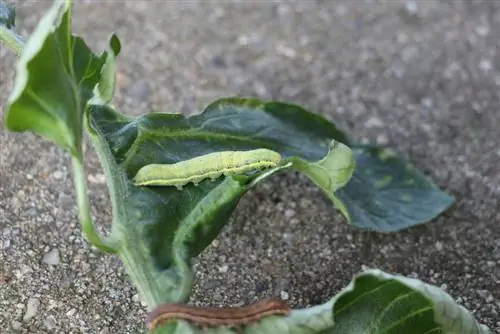
The butterflies' eggs are very robust and survive the winter without special frost protection. They are deposited on various parts of plants during the summer and attach themselves there so that they do not fly away in strong winds. However, they are attached to the parts of the plants and are also optimal food for their predators. Spiders, frogs and beetles are just a few examples of animal species that find butterfly eggs very appetizing. This is another reason why the number of butterflies is continuously decreasing.
Tip:
The female butterflies predominantly prefer plants for laying eggs, which also serve as a food source. In order to protect the eggs from hungry enemies, it is recommended to check them again and again, especially during the summer, for eggs that have been laid. If any are found, you should cut off the affected parts of the plant and store them, for example in a garden shed or a garage, where the ambient temperature is approximately the same as the outside temperature.
Examples of butterflies that overwinter as eggs:
- Hairstitch butterfly
- Apollof alter
- Kidney Spotted Butterfly
Walking Butterflies
For some species of butterflies it is simply too cold in Western Europe and their bodies are unable to respond to icy winter temperatures in a way that can survive. These are usually species of butterflies that originally come from warmer climes and moved to Western Europe for the summer. That's why most of them head back to the cold-free south in early autumn. The following spring, most of the new generations come back after some of their mothers have flown over the Alps into southern Europe or even Africa.
However, the number of butterflies flying to Western Europe varies. This is based on various factors, primarily related to immigration and flight conditions. Frequent storms, numerous rainy days and strong temperature fluctuations mean that fewer and fewer make the journey or do not survive. But now some of the migrant butterflies stay here in the winter. This is due to climate change, which is making winters continually shorter and average temperatures higher.
Butterflies that spend thewinter in the warm south are for example:
- Admiral Butterfly
- Pigeontail
- Postillon butterfly
- Painted Lady
Garden wintering
So that butterflies can spend the winter in the home garden in every development cycle, it is important that optimal conditions for a (safe) winter quarters are created or maintained. First and foremost, you should not cut off spent flower stems or perennial plants in late summer or fall. They offer a preferred overwintering place for butterfly caterpillars and pupae and, in the worst case, could be accidentally thrown away when separated if they have already attached themselves.
Since butterflies in every phase of development and as moths also like to seek protection from the cold in climbing plants on facades protected from the wind, cutting them back in autumn would probably mean death for many of them. It is therefore advisable to avoid pruning in autumn and postpone it until spring, when the “summer birds” have left their winter quarters again.
Home winterization
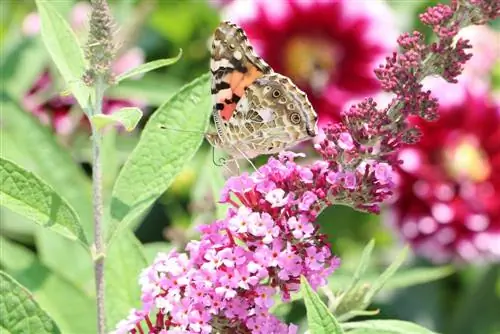
If a butterfly, regardless of its life cycle, “strays” into a house in the fall, overwintering here usually means death.
Temperatures above 12 degrees keep them from winter torpor or make them wake up. This means that they become or remain active, which in turn results in increased energy requirements. However, since there is no food to be found in winter, they cannot consume any energy and will ultimately starve. But simply putting them outside in the cold would also cost them their lives because they would immediately freeze to death if they were not used to the cold. It is therefore important that you carefully relocate the butterflies from warmer environments to colder places where the temperatures are at least 12 degrees Celsius, preferably around five degrees Celsius.
You can proceed as follows:
- Carefully slide the butterfly into a small cardboard box with a lid
- There must be a sufficiently large opening in the upper area for coming out in spring
- Initially the opening remains closed
- Place closed box in a cold place, such as garage or garden shed
- After about a week, the ambient temperature inside the box should be cold
- The winter torpor sets in or deepens
- Expose the opening in the lid
- If possible, avoid disturbances such as noise
- After the winter torpor, the butterfly leaves the box independently in spring
Tip:
If the ambient temperature falls well into the minus range, it is advisable to move the box to a cool basement room for this period. Even if it is warmer there than recommended, the chances of survival are still higher here than if the butterflies are exposed to temperatures of minus 20 or more.
Conclusion
Butterflies spend the cold winter time in different ways. This depends on the butterfly species and its developmental stage. Even though more and more species in Western Europe often spend the winter in hibernation, their frequency is decreasing and fewer and fewer can be seen in summer. It is all the more important that habitat for their winter quarters is preserved or created and that you help the “summer birds” in every life cycle if necessary so that they can survive the winter season.


